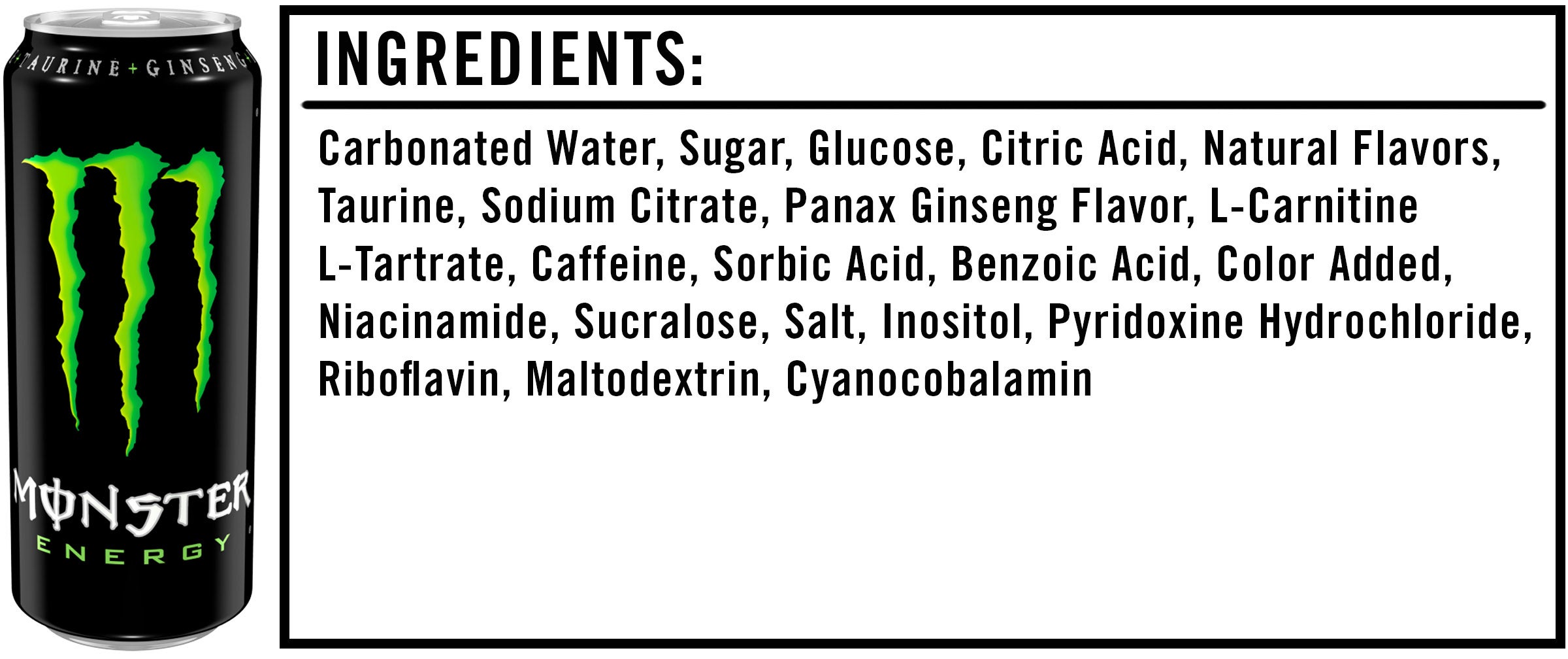We’re often told that you should never eat anything (or put anything on your body) if you don’t recognize everything on the ingredients list. But since most of us have no idea what xanthan gum or potassium benzoate are — or more importantly, what they’re doing to our bodies — we’re decoding the ingredients in the many things Americans put in (and on, or near) themselves.
This edition: Monster Energy drinks, which are made from 21 separate ingredients that we’ve broken down as they appear on the Walmart website, since Monster Energy doesn’t list them on their own website.

Ingredients
1) Carbonated Water: Bubbly!
2) Sugar: One can of Monster contains a frightening 54 grams of sugar, as much as two Snickers bars and nearly 20 grams more than what the average man should consume in an entire day. Eesh.
3) Glucose: Sugar in its simplest form.
4) Citric Acid: Citric acid naturally occurs in citrus fruits and is often added to foods to extend their shelf life. It can also lend some sourness.
5) Natural Flavors: Natural flavors are flavors derived from an actual food source, like lime flavoring taken from actual limes.
6) Taurine: Taurine is an essential amino acid, and some studies have found that it improves mental performance when combined with caffeine. Taurine also appears to be the impetus behind the ongoing rumor that claims energy drinks contain bull semen, which was debunked (thank God) by Snopes: “The composition of that substance’s name — ‘taur’ being a Greek/Latin root for ‘bull,’ and the ‘-ine’ suffix denoting something derived from the preceding root — suggests to the casual observer that taurine is something made or excreted by a bull, possibly something like ‘bull urine.’”
7) Sodium Citrate: Sodium citrate is the sodium salt of citric acid. It acts as a preservative and can lend a sour taste when added in high amounts.
8) Panax Ginseng Flavor: Panax ginseng is a plant native to East Asia and is believed to improve certain brain functions, like memory and mood, when consumed as a supplement. That said, it seems to act primarily as flavor in Monster Energy drinks.
9) L-Carnitine L-Tartrate: L-carnitine L-tartrate is a common supplement used by athletes, because it can be absorbed quickly and helps with muscle soreness and recovery.
10) Caffeine: A can of Monster Energy contains 160 milligrams of caffeine, the same as two Red Bulls. That may seem like a lot, but the FDA says 400 milligrams a day is “not generally associated with dangerous, negative effects.” It will definitely still get your heart pumping, though.
11) Sorbic Acid (Preservative): Sorbic acid is a preservative used for its antimicrobial properties and is “generally recognized as safe” by the FDA.
12) Benzoic Acid (Preservative): “Benzoic acid most commonly functions as a preservative in foods and cosmetics,” Dagan Xavier, ingredient expert and co-founder of Label Insight, explained to me during my analysis of the ingredients in Pepto-Bismol. “It can also be used to add fragrance to a product.” Various studies found that benzoic acid is poisonous in large doses, but it would be near impossible to consume enough of the stuff in foods and drinks for it to be lethal.
13) Color Added: Artificial colors are known to be carcinogenic. However, as physician and biochemist Cate Shanahan explained during my exploration of Doritos, studies claiming this often use unreasonable amounts of artificial colors in their experimentation, so try not to worry too much.
14) Niacinamide (Vit. B3): This B vitamin improves cholesterol levels and lowers cardiovascular risks.
15) Sucralose: This is an artificial sweetener more commonly known as Splenda, and I have no absolutely idea why Monster Energy drinks need more sweetness in addition to the 54 grams of sugar they already contain. Unfortunately, studies suggest that sucralose increases the populations of bacteria in our gut that pull energy from our food and turn that energy into fat. Or in simpler terms, sucralose may make us overweight.
16) Salt: Just a sprinkle for the sake of flavor and electrolytes.
17) Inositol: Otherwise known as vitamin B8, inositol might help balance certain chemicals in the body to reduce symptoms of various mental conditions (like panic disorder, depression and obsessive-compulsive disorder).
18) Pyridoxine Hydrochloride (Vit. B6): This helps the brain create serotonin (which regulates mood) and norepinephrine (which helps the body cope with stress).
19) Riboflavin (Vit. B2): This helps the body break down carbohydrates to create energy.
20) Maltodextrin: An artificial sugar made from maltose (aka malt sugar) and dextrose, maltodextrin is usually a filler ingredient to add bulk to processed foods and drinks, and to increase their shelf life — maltodextrin itself has a shelf life of two years.
21) Cyanocobalamin (Vit. B12): This keeps nerve and blood cells healthy. Low levels of vitamin B12 have also been associated with premature ejaculation, so Monster Energy drinks surprisingly might not be the worst choice if you need help with that.
The Takeaway
All things considered, Monster Energy drinks are a grossly unhealthy way to caffeinate. They contain more sugar than anyone should consume in a day — and possibly even several days — a hefty dose of artificial sugars and a few controversial preservatives that are worth avoiding whenever possible.
My suggestion? Consider coffee instead.

